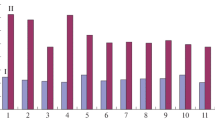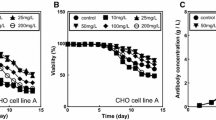Abstract
It was found that the production of human monoclonal antibodies (MoAbs) by human-human hybridomas can be significantly enhanced by replacing glucose with fructose in the dish culture medium. Optimization of initial concentrations of fructose and glutamine, another influencing factor for MoAb production, enabled an enhanced production of human MoAb 2.1 times higher than that obtained using the conventional culture media employing glucose. It was shown by kinetic analysis that enhanced MoAb production at the optimum fructose concentration can be attributed to the retention of high specific antibody production rates and diminished time lag during the course of culture.
These dish culture results with fructose-containing medium were successfully applied to the continuous perfusion culture with a slight modification, where 2.9- and 1.9-fold enhancements in specific antibody production rate and MoAb concentration, respectively, were attained as compared with the conventional glucose-containing medium.
An inverse relationship was observed between the secreted concentrations of lactic acid and MoAb when the hybridoma was cultured in the media containing varying concentrations of fructose, i.e., the lower the lactic acid concentration, the higher the MoAb production andvice versa, suggesting that fructose at appropriate concentrations in the medium can serve as an alternative sugar for the efficient production of human MoAbs, with reduced pH shifts, for the serum-free culture of human-human hybridomas.
Similar content being viewed by others
References
Duval D, Demangel C, Miossec S and Geahel I (1992) Role of metabolic waste products in the control of cell proliferation and antibody production by mouse hybridoma cells. Hybridoma 11: 311–322.
Griffiths JB, Looby D and Racher AJ (1992) Maximisation of perfusion systems and process comparison with batch-type cultures. Cytotechnology 9: 3–9.
Harbour C, Barford JP and Low KS (1988) Process development for hybridoma cells. In: Fiechter A (ed.) Advances in Biochemical Engineering/Biotechnology, Vol. 37 (pp. 1–40). Berlin, Springer-Verlag.
Hashizume S, Sato S, Matsuyama M, Tamaki S, Hanada K, Murakami H, Yasumoto K, Nomoto K, Nakano K and Kusakabe K (1990) Accumulation of125I-labelled human monoclonal antibody (HB4C5), specific to lung cancer, into transplanted human lung cancer in nude mouse. In: Murakami H (ed.) Trends in Animal Cell Culture Technology, (pp. 167–172). Tokyo, Kodansha.
Imamura T, Crespi CL, Thilly WG and Brunengraber H (1982) Fructose as a carbohydrate source yields stable pH and redox parameter in microcarrier culture. Anal. Biochem. 124: 353–358.
Kaltenbach JP, Kaltenbach MH and Lyons WB (1958) Nigrosin as a dye for differentiating live and dead ascites cells. Experimental Cell Research 15: 112–117.
Kamei M, Hashizume S, Sugimoto N, Ozutsumi K and Matsuda M (1990) Establishment of stable mouse/human-human hybrid cell lines producing large amounts of anti-tetanus human monoclonal antibodies with high neutralizing activity. Eur. J. Epidemiol. 6: 386–397.
Khazeli MB, Saleh MN, Wheeler RH, Huster WJ, Holden H, Carrano R and LoBuglio AF (1988) Phase I trial of multiple large doses of murine monoclonal antibody CO17-A. II. Pharmacokinetics and immune response. J. Natl. Cancer. Inst. 80: 937–942.
Low K and Harbour C (1985) Growth kinetics of hybridoma cells: (2) the effects of varying energy source concentrations. Develop. Biol. Standard. 60: 73–79.
McCabe RP, Peter LC, Haspel MV, Pomato N, Carrasquillo and Hanna MG Jr. (1988) Preclinical studies on the parmaco-kinetic properties of human monoclonal antibodies to colorectal cancer and their use for detection of tumors. Cancer Res. 48: 4348–4353.
Merten O-W (1988) Batch production and growth kinetics of hybridomas. Cytotechnology 1: 113–121.
Mochizuki M, Kato M, Sato S, Hashizume S, Murakami H and Nomoto K (1991) Characterization of a lung cancer-associated human monoclonal antibody HB4C5. Hum. Antibod. Hybridomas 2: 116–123.
Murakami H, Hashizume S, Ohashi H, Shinohara K, Yasumoto K, Nomoto K and Omura H (1985) Human-human hybridomas secreting antibodies specific to human lung carcinoma. In Vitro Cell Develop. Biol. 21: 593–596.
Ohashi H, Hashizume S, Murakami H, Aihara K, Shinohara K and Omura H (1979) HO-323, a human B lymphoblastoid cell line useful for making human-human hybridomas. Cell Biol. Intl. Rep. 10: 77–83.
Omasa T, Ishimoto M, Higashiyama K, Shioya S and Suga K (1992) The enhancement of specific antibody production rate in glucose- and glutamine-controlled fed-batch culture. Cytotechnology 8: 75–84.
Reitzer LJ, Wice BM and Kennel D (1979) Evidence that glutamine, not sugar, is the major energy source for cultured HeLa cells. J. Biol. Chem. 254: 2669–2676.
Reuveny S, Veles D, Macmillan JD and Miller L (1986) Factors affecting cell growth and monoclonal antibody production in stirred reactors. J. Immunol. Methods. 86: 53–59.
Sato S, Murakami H, Sugahara T, Ikegami T, Yamada K, Omura H and Hashizume S (1989) Stimulation of monoclonal antibody production by human-human hybridoma cells with an elevated concentration of potassium or sodium phosphate in serum-free medium. Cytotechnology 2: 63–67.
Schneider Y-J and Lavoix A (1990) Monoclonal antibody production in semi-continuous serum- and protein-free culture: effect of glutamine concentration and culture conditions on cell growth and antibody secretion. J. Immunol. Methods 129: 251–268.
Yano T, Yasumoto K, Nagashima A, Murakami H, Hashizume S and Nomoto K (1988) Immunohistological characterization of human monoclonal antibody against lung cancer. J. Surg. Oncol. 39: 108–113.
Author information
Authors and Affiliations
Rights and permissions
About this article
Cite this article
Mochizuki, K., Sato, S., Kato, M. et al. Enhanced production of human monoclonal antibodies by the use of fructose in serum-free hybridoma culture media. Cytotechnology 13, 161–173 (1993). https://doi.org/10.1007/BF00749812
Received:
Accepted:
Issue Date:
DOI: https://doi.org/10.1007/BF00749812




